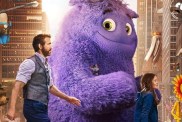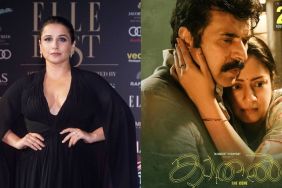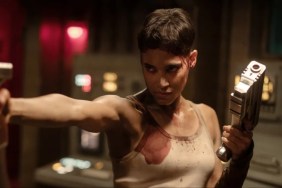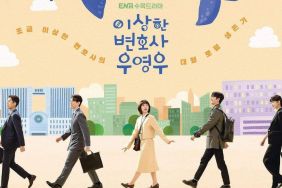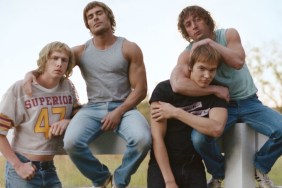In case you weren’t aware, Zack Snyder is releasing a new movie this week. Although the 300 and Watchmen director’s name isn’t plastered all over every ad for it, Legend of the Guardians: The Owls of Ga’Hoole is his latest opus, and it’s no mere kid stuff, even though the film is indisputably aimed at a younger audiences than his usual, beautifully brutal efforts. An adaptation of the first three books in Kathryn Lasky’s acclaimed series of children’s novels, Snyder’s film combines the source material’s sweeping, epic storytelling with the best of the director’s distinctive visual style to create a sophisticated, mature animated film that offers thrills for audiences of all ages.
ComingSoon.net joined other members of the press in Los Angeles earlier this week to talk about “Legend of the Guardians” with Snyder, his wife and producer Deborah Snyder, and stars Jim Sturgess and Ryan Kwanten. In addition to detailing the process of developing and adapting the source material, Snyder and co. reflected on their personal and professional motivations to participate in the film, and offered some insights about the substance of “Guardians” that elevates it above the ranks of regular animated movies.
ComingSoon.net: Jim, can you talk about how you developed the voice of your character? It’s a great performance that really captures the sense of wonderment and spirit of Soren.
Jim Sturgess: That’s an interesting one. When I first found out that I’d got the part, I went on to my computer and I started to practice with the voice. I did it on a program called GarageBand which is on my laptop and I started to try different things to see how the voice was going to work. Obviously, trying to get an Australian accent was the first thing I had to try and get through. I realized that without the use of your eyes and your face, I thought, “Oh God, I’m going to really have to amp up my voice and really try and make it as expressive as possible.” So I almost overdid it. I was overkilling it and shooting high. And then, I remember when we came for the first day to do our first session of putting it together, I was like “Okay, I’ve got this character down. I’m really going to overplay it.” I guess forgetting that these incredible animators would put in the eyes and would put in all these expressions so I really overdid it at first and then had to draw myself back and realize that there would be an acting performance and it would be created by these incredible animators that would do that job for me really. So once I understood that, I could play it as you would if you were making a film, I suppose. It wasn’t a radio play. You didn’t just have to use your voice. That wasn’t the only tool that you had. These incredible animators would put in
I saw the film last night for the first time and I couldn’t believe the expressions they were able to put on these owls’ faces and to put the comedy in there just by a look or the intensity in the eyes. It just blew my mind.
CS: Ryan and Jim, do you have brothers yourselves? And if so, when you were younger, was there a rivalry for your dad’s attention?
Ryan Kwanten: You go first, Jim, and then I’ll shoot you down.
Sturgess: Oh cheers, thanks Ryan. I do. I have an older brother and a younger sister so I’m the middle child. Like Kludd and Soren, I am far more courageous than my older brother. I’m better looking and a better flyer. I mean, me and my brother get along really well so we don’t have that kind of rivalry.
Kwanten: I am actually an older brother and I too, like Kludd, suffer from what I have diagnosed as OSS which is Older Sibling Syndrome where you feel the need to set an example, a fine example, and you don’t necessarily possess the natural gifts of your younger brothers. I know I didn’t, and Kludd certainly doesn’t. I think the older brothers too also suffer from a need to be overly ambitious. I try and use that for good. Kludd, on the other hand, was easily persuaded to the more darker side.
CS: Zack, is it a tricky balance between doing something that would keep your fans of “300” and “Watchmen” happy and doing something that families and kids, who might have no idea who you are or what other films you’ve done, would enjoy?
Zack Snyder: Who are these kids? (Laughs) No, I’m just kidding. I honestly didn’t think about it that way because the truth is we started working on the movie about three years ago. Before we started shooting “Watchmen,” we were working on this movie so it doesn’t really fit in the chronology exactly, like “Okay, you’ve made all these hard core movies, so what are you going to do?” Honestly, I didn’t really think about it that I had any fans. I didn’t feel like I had anyone to disappoint. I guess our approach was really just to try and love the story and try and make some awesome pictures that supported the story and whatever language it chose, that was the language that it was told in, and again, I didn’t think about it in a chronological filmography kind of way. I just wanted to make a movie that is enjoyable and that can come at any time in your filmmaking life.
CS: Deborah, were you surprised that he wanted to do a family film after all these rumors that you won’t do anything that isn’t R-rated?
Deborah Snyder: No
Zack Snyder: This isn’t R-rated. (Laughs)
Deborah Snyder: Zack has 6 children and none of the kids were ever able to come to any of the premieres. They never saw “300.” So, they kept saying “When are you going to make something that we can see?” And when this came about, we thought “Listen, this is a great story and not just for kids, but for the whole family.” Because I know a lot of times we’d take the kids to see these animated films and we’d be like dreading it and we’d say we want something that kids will like but there’s also something in it for parents.

CS: Zack, can you talk a little about doing an animated film after doing live action? The process is much slower; did that ever frustrate you? Also, what is it like working with the actors, when you and they just have their voices to work with?
Zack Snyder: You know, it’s weird. I guess, first of all, working with the actors, these guys have done an amazing job and actually the process of when you record just a voice, in some ways it’s a lot faster and a lot easier. I won’t say easier because it’s all, from their points of view, they still have to do all the work that they would do. But I think that because you don’t have a camera and there’s no crew around and really it’s just a microphone and a conversation, it’s a slightly different process and that way I think that you can get at a lot more ideas quicker. And that part is rewarding and fun and it also gives us, when we were putting the performances together, or the film itself, the voice. I felt like there was a little bit more variety because a lot of times with a non-camera performance there’s something about the look or that one take where maybe the words were not exactly as they were written or not exactly at the idea but there was something in the performance that was so compelling that you’re like “Okay, I got it. That’s the take. It’s got to be that take. There’s no other way around it.” It’s interesting in an animated film how, just like building the pictures, it’s amazing how obsessive you get over single words. You’re actually listening to every word. “The way you said ‘the’ was odd” – in a way you would never do with a photographed performance because you just don’t.
Sturgess: It was exactly the same for us too as well because usually you are hindered by maybe you’re losing light, maybe you didn’t grab your prop on the right line. There are all sorts of things that hindered us as well but then to be given that sort of freedom, just try it again 16 different ways. Let’s see what happens. Let’s see what pops.
Deborah Snyder: We did the video tape of all their performances and it’s really fun because the animators always had a visual reference of the take and it really helped them and it’s very funny now to see the animated character and then to see our actors in the little video because a lot of times a head movement or something was really incorporated. Their movements became the character and that was a really interesting process for us to look at.
Sturgess: I never want to see those tapes.
Zack Snyder: [Art director Grant Freckelton] was saying earlier how this wasn’t like a mocap performance. We were talking about “Happy Feet” and how it’s actors with dots on their suits and then when they dance around, then the animators are able to go “Oh, we can use that movement.” So, with this movie, we didn’t do that. And even some animated movies, now everyone’s going “There’s this cool thing where if we put dots on the actors and they go like this, then we don’t have to do any animation. It’s awesome.”
CS: Zack, what sort of challenge was it to get the 3D right on this film, and what do you think that adds to the storytelling of the film?
Zack Snyder: First of all, I’d say the guys at Animal Logic have done Grant and I were saying it’s everyone’s first 3D movie but I think everyone endeavoring from the beginning to say “We’ve seen the other 3D movies and they’re awesome
ish.” We were talking about how there are rules. They say you can only make a 3D movie certain ways and you can only make certain shots. I felt like what we did is we really made this 3D movie in a cinematic way. We tried not to change the language of the movie for the 3D but we tried to get the 3D to enhance the language of the movie. The 3D isn’t used in a gimmicky way but it does deepen the world. I really believe that, especially in a fantasy film which this is, it really is a fantasy film. I was looking on the internet and it’s listed under sci-fi which is kind of cool. I liked that it was in a sci-fi category as well. But then it’s a real fantasy film so you really are going on an adventure to another world literally. We were saying we used all this landscape of Australia to create the world but in a lot of ways when you make an animated movie you get nothing for free. You’ve got to endeavor then to include anything that you see is an effort and a choice. There’s no “Oh, we got lucky with those clouds.” But you want that feeling, right? And so, I think that the cool thing about the 3D in this case was that it makes the world more immersive. It helps support the fantasy aspect of the film in the sense that you don’t have to work to believe in the world as much maybe if the 3D is working correctly.
Deborah Snyder: And also I think because we had these birds in flight and we could really use that whether they were flying towards you or away from you and create. I think it’s a very deep movie in terms of 3D more that there are times where it pokes forward, but a lot of times we’ve used it to be deep so we can see them flying through the frame and I felt like it was a very natural use of it. But I also have to say that the 2D version of the film is also worth seeing because with 3D, because of the glasses, everything is slightly darker and a little bit muddier and I feel like it’s a different experience to watch the 2D but it’s also a really awesome experience because you get more of the detail of the feathers and you just see a little bit more. You see a little bit more depth in the colors. It’s different but it’s also pretty cool too.
CS: Zack, do you have something against good old American actors?
Zack Snyder: See, that’s not cool.
Sturgess: Do I have to leave now?
Zack Snyder: What I will say is that I was blessed with an embarrassment of riches and talent in the cast that I have though in the past I have worked with American actors and I find them incredibly awesome and very talented. In the case of this film, because I was interested in this fantasy world, if you will, I think the accents and the abilities of these actors have come together to create this perfect storm of support for the fantasy world that we’ve all endeavored to create. That is not by design, the lack of American actors, it just happened to work out that way.

CS: Jim, according to online sources, you really wanted to do voiceover work for animation. What animation did you watch when you were growing up? What do you see as the differences in animation between what you used to watch and what you did in this film?
Sturgess: Just like any kid, I guess, I’d always wanted to be the voice of a cartoon character. It just seemed like a really cool thing to do. There’s been loads of animation films and I was in love with a film called “Watership Down” which was a huge part of my life as a kid when I grew up. As a kid, it’s mainly cartoons, animation and things like that which you watch and, as you get older, the animation has just been getting more and more exciting and more possibilities are going to come in with that. I’d nearly had the chance to do a few animated characters so when this came up it was just ticking every single box that I’d ever dreamed about. The story was just epic in every way and then they sent me this book of how the animation was going to look and the characters’ back stories and different designs for the claws and the weaponry and the shields and the masks. I was completely taken in by this whole world that they had already created before I’d even gotten anywhere near being involved. And it’s fun just to hear your voice in this beautifully designed character and it’s your voice. It was such an exciting film to watch. I saw it for the first time last night and it’s different than watching a film that you’re in and acting in. It’s this whole fantasy world. It’s a real buzz and a real thrill and knowing that’s your voice behind that little owl’s face.
CS: Ryan, were you inspired by any cartoons growing up?
Kwanten: I was very much living among three boys and we were kicked out of the house pretty much at any moment that we had. I think mum just thought it was easier for us to be dealt with outside of the house than inside the house. So we were then forced to use our imaginations and play outside so we must have come up with 20, 30 different games using our imagination, just taking over our backyard, the neighborhood, anything. Our neighbors were well and truly versed in our mad ways. We’d be flying through Mars starting at the hedges and all sorts of things so it was pretty much just games within my head. I wasn’t really much of a TV animation junkie growing up.
CS: The movie is beautiful. What was the most difficult scene on the technical side and also on the artistic side?
Zack Snyder: The first shot and the third shot was also hard [referring to the leaves and all of the rooms inside the tree]. What’s interesting also about when you make an animated movie, if you don’t realize
What I didn’t realize was that these assets actually get built like a real set in some ways. I’d say “Oh we should make that bigger” and they’d be like “We already built it. It’s only that big.” And I’d say “Really? That’s crazy! It’s not real.” And they’re like, “No, no, it is real. It’s done.” In some ways, every now and then, you’d get a wake-up call that’s kind of like making a real movie as far as “We’ve only budgeted this much for that set. We’ve built it and it’s this big and it cost this much to make that big and if you want to make it bigger, it’s going to cost more money and we’ll have to get more pixels from the pixel store.” I don’t know where they get them.
Deborah Snyder: And there can only be so many owls in this scene.
Zack Snyder: Yeah, it just be like extras and they’d be like “No, no
” Grant joked one time, we were talking about doing a shot, and out the window of the hollow you could see
He goes “We’ll just put a green screen back there and then we can add a different background later.” And I was thinking it was crazy. Retime is when it goes from normal speed to slow motion. And it was a problem if I suddenly said “Oh this shot should be in slow motion.” They’d be like “Ahhhhh!”
Deborah Snyder: Also, how about the feathers? It’s one thing that you take for granted, but when the owls touch each other, there’s this scene with Soren and Eglantine and he leans down and actually all the feathers kind of…
Zack Snyder: Their heads knock together.
Deborah Snyder: They knock together and that was such a difficult [scene]. It’s something that most people won’t even notice but it was something that was such a difficult thing to do.
CS: Jim and Ryan, many big name actors obviously have been leading the way and lending their voices to animation. Do you feel that animation and voice work are now equally legitimate as any acting job you can get and would you consider doing this again perhaps even a sequel?
Sturgess:: Would I? Yeah, of course. I mean, 100%. I think what’s exciting about animation is as an actor you want to play characters and it’s not often in film you get the chance to play a baby owl. Animation requires you to play a variety of really extreme things you wouldn’t necessarily be able to play on film or in the theater. So, yeah, that for me is a reason for why animation would be exciting and why actors are interested in that sort of platform to act in. It’s like what Zack and Ryan were talking about earlier. It’s a different way of acting and that’s always exciting as an actor to try out new platforms in which to play different characters. So I can see why a lot of people are drawn in by that.
Kwanten: I was also thinking that you have different dimensions–the 3D aspect with this–but there’s also more than one dimension in terms of acting. I felt like a lot of these animation films don’t have the character development. It’s very like a one dimensional kind of character where they don’t have the specific arc. Even the smaller characters in this have more than at least one thing to play and there’s a journey that they go through and I know particularly for my character that was a really appealing thing for me that he starts off as this misunderstood, misguided owl and then it’s this one single decision that changes the course of his life and that tells more about who he is than the whole lifetime moments before that, how he chooses to react in that moment. Yeah, I would also gladly partake in a sequel.

CS: Ryan, while this filmed over the past three years, did you film during your time off of “True Blood” to do your part and when you did go in, was it kind of a relief from all the action on “True Blood” because you were just using your voice on this? And, do you see any similarities between Jason Stackhouse and Kludd?
Kwanten: Yes, I did go in. Yes, it was a nice escape but this was also incredibly hard. The amount of times that I left the 2-3 hour voicing session with sweat pouring off because you’re doing all the various levels of exertion. There’s that happy, joyful exertion, then sort of exasperated at Kludd not being so eloquent with the way he flies. So, yeah, there weren’t too many times where I left with an abundance of energy after. Just going back, sure, it was a nice relief from playing Jason. I love playing that character but when I’m not shooting, that’s the last thing that I want to dive into to be honest.
CS: So no similarities between the two of them in terms of emotions of anything?
Kwanten: I think there’s a vulnerability to them both and an innocence, but I think Kludd has more willpower and perhaps more mental capacity.
CS: Zack, I would like to know more about the casting process. How does it work when you’re looking for a voice more than a face?
Zack Snyder: I gotta say I didn’t do like a “Okay, let’s shut off the sound” or “Shut off the picture and just listen to the voice.” I didn’t really do that. With these two (Jim Sturgess and Ryan Kwanten), I was a fan of their work anyway so I thought about it in the sense that okay, what I’ve seen them do in the past and where emotionally I feel like I’ve seen them go just made me confident that whatever I could throw at them with these characters, they would be able to tackle it. Again, it’s like anything, I think that as you develop an idea as to who this character is, you have an idea who they are and then when the actor comes in and does their version of it, the awesome thing that I get to watch happen is that we all in the story department and when we’re making the movie and we’re talking about who the characters are before we have the actors, they’re like they’re here, and in some ways just because it’s so complex, you kind of flatten them out a little bit. You tend to want to flatten them out a little bit just so you can keep them in your head as far as who they are. You tend to go “Okay, this is their journey and this is their arc.” You try and simplify it a little bit more because I think if try and think about it in a super complex way, you have this crazy graph that is the character and it’s hard to lock it in. The awesome thing that an actor brings is they’ve lived that moment. It’s been my experience and the joy for me in my job is that they come and make it way better than you ever thought it could be. When it’s emotional, it’s way more emotional. When it’s intense, it’s way more intense and when it’s sad, it’s sadder. It’s all those things or more joyful than you can imagine. And then, subtlety, of course. It’s so much subtler than you could ever [imagine]. “Oh my gosh, that’s so much more complicated than I could have imagined. And those are the things. And what these guys have done an amazing job with is actually making these guys so much better. I guess as far as when I say casting, you have “Oh gosh, I wonder if Ryan would do this. And then, I wonder if Jim would do this.” And then, when they come in and they start to make it real, you’re like “Wow! Okay! It’s awesome.”
Deborah Snyder: What was really interesting that we did on this film before we started the casting process that we haven’t done in any of our live action films was we workshopped the characters because you were starting from scratch. And because they were a creature, they were owls, we were trying to define what they looked like, Zack and I went to Animal Logic and I think for a week we took every day one character and we sat down with all the animators and we came up with all their attributes and it was really an interesting process so we had an idea of what the character was and then we went into the casting process.
Zack Snyder: It was almost like writing a novel–how you might sit down and do a whole essay about a character–a big, long document that supports the character, everything about them.
CS: Zack, you have 6 children?
Zack Snyder: Yes, six. My youngest is 10 and I have a 12-year-old, two 13-year-olds, a 15-year-old and a 17-year-old.
CS: Was one of them a fan of the book?
Zack Snyder: No, but my 12-year-old who’s 12 now, he’s read all the books.
CS: Have they all seen the film and what do they think of it?
Zack Snyder: They’ve all seen the film. They think it’s awesome.
Deborah Snyder: They saw the film along the way which was kind of great.
Zack Snyder: In some ways.
Deborah Snyder: We had a built-in focus group and we would have these story reels and we’d be like “Okay, sit down and we’re going to play this.” And then we’d be like “Okay. Which parts are boring? Which ones did you like?” And we got some feedback because they were pretty honest.
Zack Snyder: The truth is, it’s like we started making the movie 3 years ago, so at the age that the kids were at about 3 years ago, my 10-year-old was 7 which is where I was going for. They’ve all grown. Jett was 7 and we were like “Okay, I’m going to make a movie for you. This is going to be awesome.” And now he’s 10. So, he still likes it but it’s

CS: Was the intensity of the action a concern at all in this whole process?
Zack Snyder: You mean as far as am I going to scare them?
CS: Or kids in general?
Zack Snyder: For me, I wanted to make an adventure film like “Star Wars” or “Narnia” or “Lord of the Rings” or something like that, that I personally as a child [would like]. I guess the whole thing for me was that I wanted to take what Kathryn (Lasky) wrote in the books and treat it seriously because I knew this was going to be a kid’s fantasy film and the last thing I wanted to do is–I don’t want to say belittle but–smirk at their fantasy that they believe is 100% real and they take 100% seriously. Far be it from me to make–I don’t want to say a joke but–like “Oh! Owls are wearing helmets! Hilarious!” Where, for me, the thing that makes it strong is that I’m just like “No, that’s real. That’s the way I want to approach it.” So, the byproduct of that maybe being that the battles are intense or that the reality of the consequences is real. I wanted that to be so that it’s immersive, so the kids, at the end, are like “Oh my gosh, that happened!” Look, I was a huge fan of “Star Wars.” I love that sort of Joseph Campbellean hero’s mythic journey and I really wanted that experience in the movie.
Deborah Snyder: But also because of this process, I think animation for us was slightly different than making a live action film whereas you tested a lot because once you go down the line, you’re pretty much down the line so you’re testing it early on and one of the things that we always were conscious of is what is that tipping point? You don’t want the kids to be afraid. I think sometimes parents are more protective and the kids really seem to like it. We’d be like “Okay, what’s your favorite part?” “We like all the battles. Can you add more?” And I think really we were trying to be very careful of giving them that adventure but also I think giving them something
I think that there’s morality. There’s a lot of really great, positive messaging that balances all of that out. And there’s a little humor that balances out the intensity too.
Zack Snyder: I think it’s funny when you actually watch the film, I tried to just surf it so that right when it gets super intense, there’s something that happens that lets you off the hook and then it does this.
CS: There’s such a blur now between reality and animation, is there any more that can be done visually than what we’ve seen? Because this was amazing.
Zack Snyder: Can it be better? Do it over one more time. Didn’t we say on the last day when we finished, I said if I was like Howard Hughes or someone, and I was financing the film myself, I would have said “Okay, now let’s do it one more time. I feel like we’ve got it. We can film it. Let’s just start over and do it one more time. I think it’s close.” It’s funny, because even in the books themselves, inside there’s an owl language. There’s owl anatomy. Some of those books, if you open them, there’s all sorts of poetry. It’s crazy. You should definitely do that if you get the chance.
CS: Are you working already on the sequel?
Zack Snyder: No, not this minute.
CS: “Sucker Punch,” your next movie, is such a wild, complex idea. As you’re getting closer to finishing that, how is that shaping up and has it surprised you how it turned out compared to how you imagined it?
Zack Snyder: It’s shaping up quite nicely. We’re almost done with it. It has been quite a wild journey just getting that crazy thing into it’s exactly the same in some processes. You start out with what you feel like is kind of a sketch and then once the actors are there and now suddenly you’re building Samurai or whatever it is and they’re fighting. It starts and then you have to make choices about where to put the camera and all that. Then it starts to be real. I guess the thing that surprised me most was that the girls did such an amazing [job]. They just believed it 100% and even though it was some crazy world that I had come up with that was completely ridiculous, they just put their heads down and said “No, it’s real. For me, this is my reality and I’m going to take it all the way.” That’s what really surprised me the most. It goes back to the same thing that I experienced whenever you get to work with actors and they take your ridiculous idea and they make it awesome. It’s an awesome joy for me to have that experience.
CS: The final fight scene is very reminiscent of “300.” I was wondering if there are any homages in the film at all?
Zack Snyder: I don’t think we have a “300” homage, but there is a Night Owl Cowl. You know where all the helmets are? One of them is the Night Owl Cowl from “Watchmen.”
Legend of the Guardians: The Owls of Ga’Hoole opens in 3D, 2D and IMAX 3D theaters on Friday, September 24.


